You in my – I say!
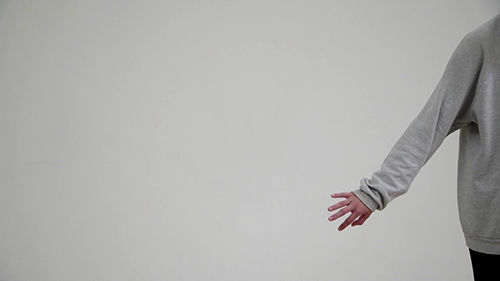
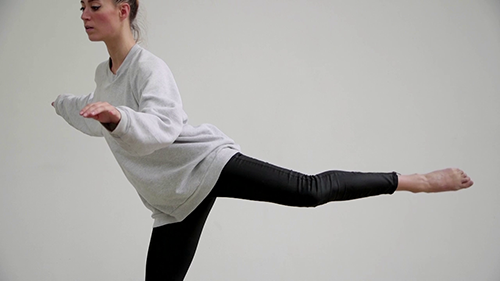
Nicole Bachmann, I say, 2017. Video stills
To write a text in response to Nicole Bachmann’s new installation piece I say, on display for the first time in her personal exhibition at Corner College, is a challenge that needs commitment to find its form. Bearing in mind the shades produced by the contrast between performative and constative speech, writing this kind of text immediately dwells in the constative language and its descriptive and analytical functions. I wonder to what extent I can allow myself a certain amount of freedom to escape this format without discarding the responsibility to carefully follow the artist’s practice and reflect on her work?
I see this text as a modest contribution on Nicole Bachmann’s work, whose artistic qualities and rigorously elaborated artistic language induce a “pure experience” of the aesthetic phenomenon in the abstracted language of her (con-)text oriented performative piece. It is rather a companion to her work that aims to give the audience at least some insights into the method of Bachmann’s practices and the artistic process of the construction of I say. Should it fail to add extra elements to amplify the artistic context, it can at least be read as a supplement that gives an account of our collaboration and the embodied strange ‘unity’ of two uncompleted gestures, that of the artist, and that of the curator, traversing the domain of language and performance.
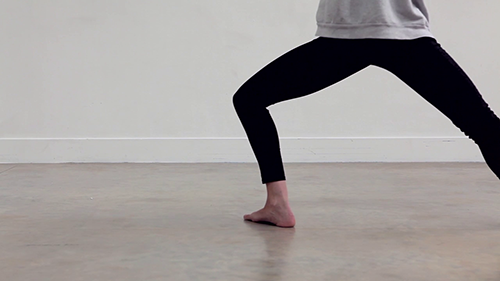
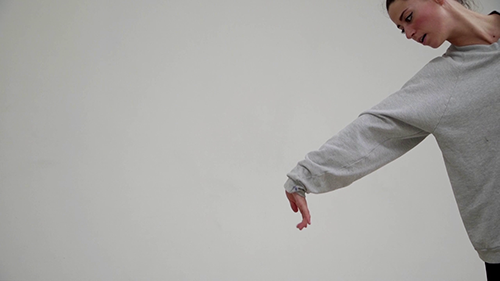
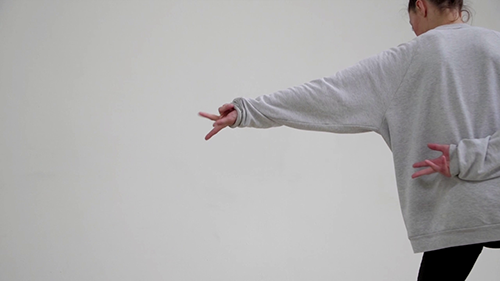
Nicole Bachmann, I say, 2017. Video stills
If I say is presented at Corner College as a video and sound installation, it is actually a filmed performative life study. Performed. Repeated. Recorded. Repeated. Performed. (Every time different!) It is a performance study for the camera rather than a choreography, involving three cameras, three actors, body movements, and sound coming from three channels among which the voices of the actors are split and installed across the space to amplify the dialogical principles of the work, while the moving image is seen on both sides of one screen. The video is composed of close-up frames, giving a sense of the space without showing it. Haptic, to be touched with the eyes, as the unframed screen installed across the exhibition space merges into that space.
The moving image is not primary. It plays to an omniattentive audience1 by splitting its attention between the different activities of listening and watching. Bachmann emphasizes the importance of the sound in I say by studying the principles of living speech and how the speech act is constituted and performed. It not only reflects on but employs the mechanisms of producing presence, when the script and the written text become an unstable and fragile ground that falls apart irreversibly, only to return again, different to itself. I try over and over to say, I try to hear you / I don’t hear you, in the dynamics of the relation I / you, which the artist inventively inverts to you in me. I say constitutes the conditions to be affected and to affect, an affirmation of life in which “the function of the speech is not discursive but existential.”2
I say explores the relation between the liveliness of the sound and the activity of listening by intensifying the microprocess of forming words so as to enunciate them. It unfolds the micropolitics of language structures in close relation to body movements in the plural and singular, to ask how the speech affects the body, instituting corporeal vulnerability and body resistance. The artist employs warm-up techniques of voice practices in actors’ routines, when they rehearse and test speech sounds in order to speak clearly during the performance. In Bachmann’s approach, the rehearsal is a performative situation evolving new emotions and affects in ever changing environments to mobilize the power of the voice with the materiality of the abstracting machine in the body in the variations between the combination of selected and collected words. In Samuel Beckett’s assertion, “make the limits of our language tremble,” one can grasp how I say produces a breathing space at the limit when the forms appear – a space of knowledge.
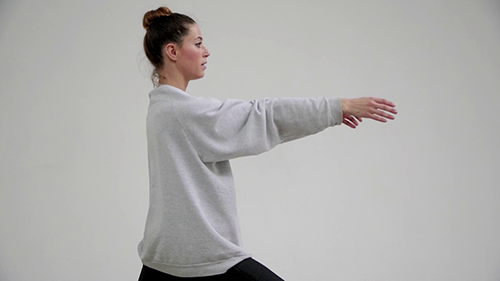
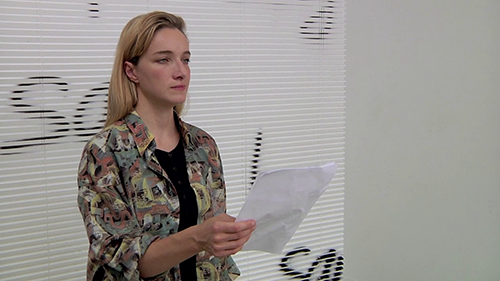
Nicole Bachmann, I say, 2017. Video stills
Bachmann’s artistic method in I say formalizes the laws that govern the language system and its apparatuses to open them to a state in which they cannot be closed or complete, and become a ground for experiments. In her artistic practices, formalization is an aleatory device that comprises the performative qualities of a performance that is impossible. The performance undoes itself and turns into a performative process that betrays the performance. I say is an art work which remains fundamentally incomplete and constitutes unfinished moments of difference in the polyvalent and open form of a mobile structure constructed by variations, playing on the juridico-political production inherent in language. Without mediation and representation, it intervenes in the institutional foundations of the origin of the law of language to find one’s voice and speak for oneself. Bachmann connects her piece I say to activism and the political movements. Like in Judith Butler’s political engagement with language, the artist pursues “the material conditions for speech and assembly [that] are part of what we are speaking and assembling about.”3
The function of the ‘script’ in I say and in Bachmann’s practices is minimal, with no plot that produces a story. It lays out the plane or table of the (con-)text,4 where there is no text in the literary sense. If Bachmann’s script /(con-)text is a kind of ‘belles-lettres’ that breaks with narrative-based texts, it can be seen as a device of alternation to activate an other space of knowledge that weaves together, intermixes and displaces. It is rather a score, or notated event of performative operations, both dynamic and visual, that contains in itself potentialities and elements of chance that draw a diagram of slight movements and micro sequences that change the language structure. The script in the process of making I say is an active ground for (un)grounding improvisations – an active grid of sound variations of sound and their affective resonances, vocal tracts and other registers. Its practical function is to (per-)form the circumstances of the settings for the event. It works as a compositional box of tools or text device closer to the technical drawing of a blueprint. Or a program/model defined by a finite set that contains in itself infinite free variables that per-form and escape to the outside of its own interiority. (Con-)text is to be understood as word(s) surrounded by other words. Bachmann employs the words in a non-literal and non-lineal sense. They are rather visually and temporally placed to pull the enunciation into a visual world where it affects the bodies. I say plays on the sound of the words to unfold the three dimensionality of the voice that nomadically occupies the space. Its architectonic deploys a sculptural, material effect.
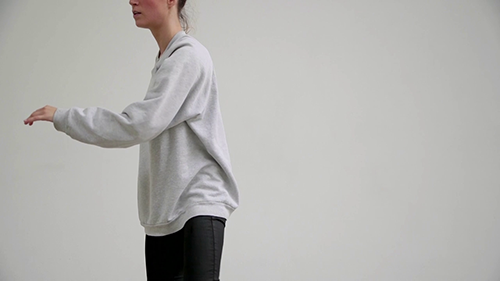
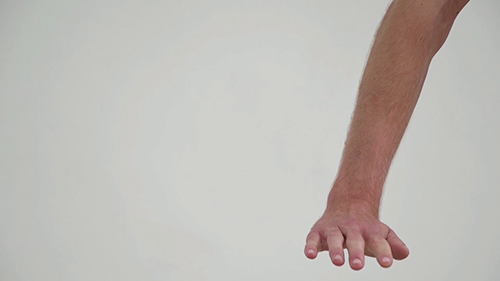
Nicole Bachmann, I say, 2017. Video stills
Bachmann simultaneously extends and shrinks the script through the practice of rehearsal with the actors, re-adapting, re-writing and re-editing it in the process in collaboration with them. The script/(con-)text forms a group of conditions and commands that Bachmann provides to the per-formers in order to follow their passages in an anticipatory performance of intuitive responses. It is a transformative device that opens a space of improvisation and expressive variations at random frequencies. For Bachmann, it is a process oriented and performative journey that walks into an unknown alley/alea (alea being Latin for dice) to find one’s own unsettled voice. It entails a restless kind of hope, as the artist finds continuing inspiration in her reading of Rebecca Solnit, hope that is “active engagement with uncertainty and the possibilities that it holds.” (Rebecca Solnit) The artist does not control. She gives directions, and insists on a collaborative togetherness. The function of the artist is to connect the specific parts, modulating unexpected breaks in a re-signified repetition.
Bachmann works with the actors, who are both her materials and her collaborators, as at the same time she lets them be not only devisers of their voice and movements, but time devisers of themselves. I say can be seen as an Erratorium in the sense of John Cage’s micropractices. The artist’s method of working with the actors resembles the work of a conductor with an orchestra, which contains the notion of the very plurality and the erratorium, as the artist leaves as much space as possible for them to improvise. The artist compounds the intensity of the time-related measures of a metronome with irregular intervals of passing time and the power of the voices/speech to form temporalities. Bachmann positions herself in the performative process of making at the conjuncture that activates multiplicities. The artist selects and collects fragments of durations and micro-temporalities to interweave and coordinate them, not as units, but as connected sets and extensive passages of displacement that have their own agency. They are timed rather than being measured linearly as a length. At one moment, Bachmann blocks the selected temporal sequences and sounds frequencies across time and space in order to film them. The artist annotates an ‘aleatory environment’ not only for the performers, but as an immersive environment created by the relation between the piece and the spectators’ movement in the exhibition space.
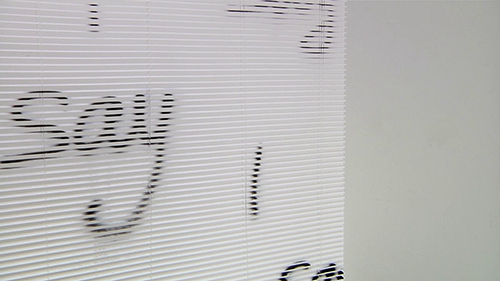
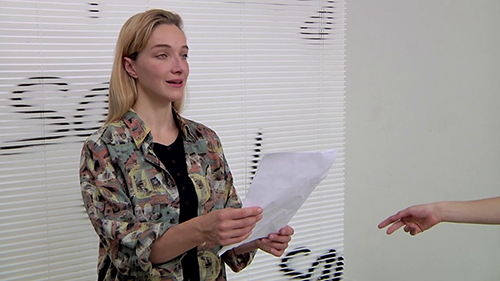
Nicole Bachmann, I say, 2017. Video stills
I say is set up by operations of blind ‘algorithmic’ machinic patterns in the system of language, without ontology or metaphysics, like the micro-movements that constitute the material grid of a reality – plural in form but singular in the construction of an event in the relativity of its ever changing equilibrium of time and space. The whole process of making the piece is determined by the presence that is at once promised and refused, an unexpected presence yet to come, form(less), an eventum before the past and after the future of the performance. A performance that has not yet happened – the presence of ‘an absolutely singular event.’ I say encompasses voices and uncompleted body movements to articulate a space of collectivity and collective practice. Let’s turn upside down the relations of singular and plural, and see plural not as a collection of singularities that produces a plurality, but a plurality (or multiplicities) that compose a singularity – all these differences in the temporality of the event that connect the body/voice/space.
I say forms, per-forms, re-forms, trans-forms, de-forms, in-forms to ex-press. Expressive! In I say, the voice is at the same time an active passage and a material object in the relation between the abstraction and the body. The voice of the actress expresses physicality with all the somatic qualities of language. The embodied voices come in and out, occupy the space with their scattering sounds. Vocal folds and unfolds flee into the space and produce a space within the space. They are the exteriority of the interiority of the space, the outside of the inside that connects the assemblage.
I say tests and asserts the very idea of the collective, which is irreducible to human grouping. It takes not only one personal voice to speak up, but a collection of voices to create an assemblage of enunciations that demonstrate the power of a non-metaphorical use of signals, signs, words and incomplete gestures that are not tied to subjectivity, but to the process of individuation, to the pre-individual realm that constitutes any kind of subjectivity yet to come. They are uprooted, nomadic fragments that fall and go underneath to rise again, free floating drops of fiction that connect to the Real. I say articulates that “the imaginary and symbolic are real.”5 In I say, Bachmann fictionalizes without forming a narrative. There is neither a story nor a rhetoric. Bachmann stresses the possibility of fiction to abstract in order to invent – a fiction on the edge that encourages other experiences of a language within language.
I say is constructed in the form of a rehearsal, taking up the exercises of daily routine of the actress, a repetition in-itself that does not lead to a performance. Performativity bears in itself the radical pedagogy of learning and unlearning, i.e., a performativity-in-itself without a performance, but it contains all the exercises necessary to support the skills needed to per-form. A world always in making, not finished yet, without imitation and without representation, being at the same time form(less) and concrete in its own incompleteness. A univocal world, a clear political enunciation that affirms all the senses in ‘the whole logic’ of the singularity. When all differences are affirmed in their singularity, that singularity differs from itself, and becomes the process of being different from itself, simultaneously singular and plural. In I say, ‘singularity is never one-off’ and never closed like a point in time and space. It is an inaugural collective process and a ‘new’ performative.
1 “Nowadays everything happens at once and our souls are conveniently electronic (omniattentive).” John Cage, letter to the Village Voice, 20 January 1966, in Richard Kostelanetz (ed.), John Cage (London: Allen Lane, 1971), p. 167.
2 Angela Melitopoulos and Maurizio Lazzarato, “Assemblages: Félix Guattari and Machinic Animism,” in Anselm Franke (ed.), Animism, e-flux journal, Issue 36 (Summer 2012), p. 54.
3 Judith Butler, “Rethinking Vulnerability and Resistance,” Madrid, June 2014, expanded version in Judith Butler, Zeynep Gambetti and Leticia Sabsay (eds.), Vulnerability in Resistance (Durham: Duke University Press, 2016), pp. 12-27, p. 13.
4 From Latin contextus, a putting together, from contexere to interweave, from com- together + texere to weave, braid.
5 Maurizio Lazzarato, Signs and Machines: Capitalism and the Production of Subjectivity, trans. Joshua David Jordan (Cambridge/MA and London: Semiotext(e) / Foreign Agents, 2014), p. 75.
